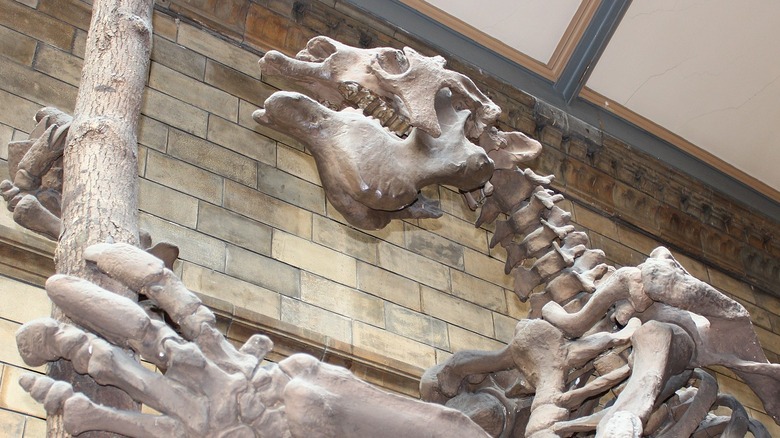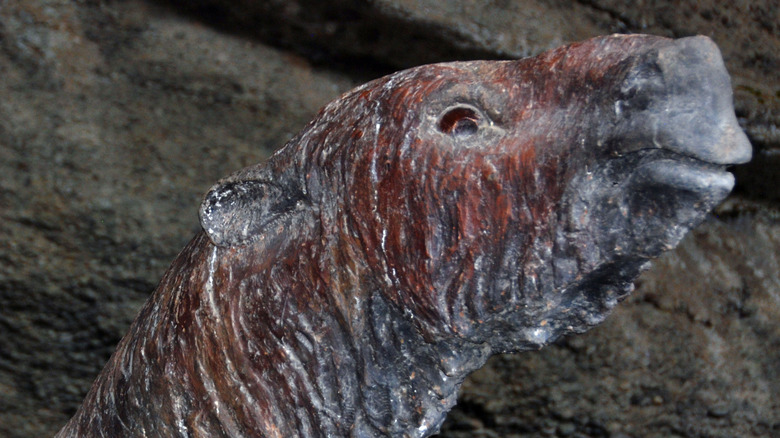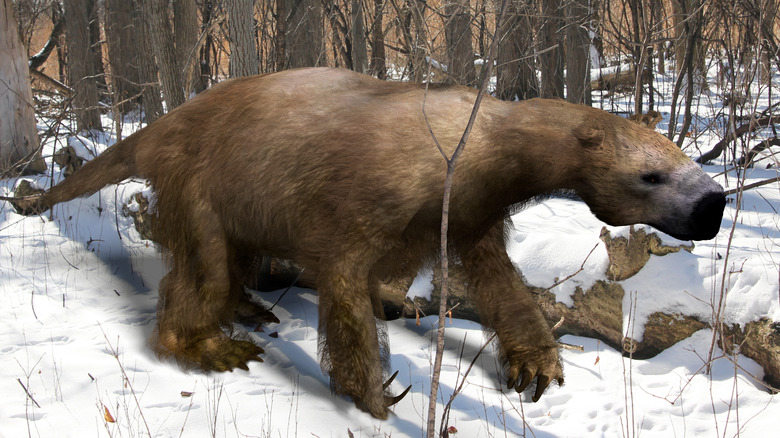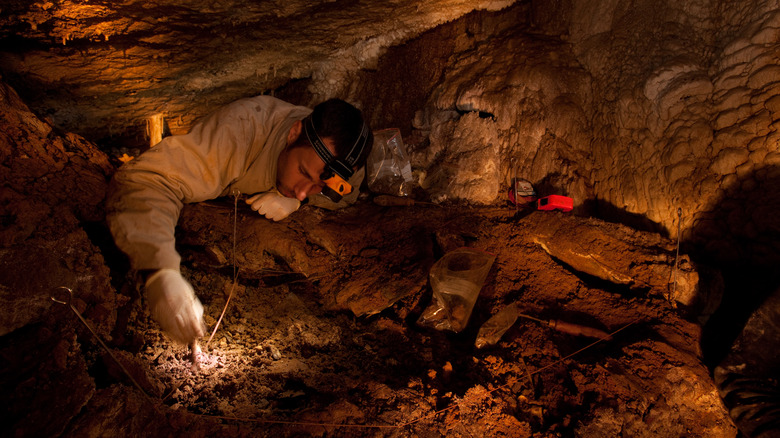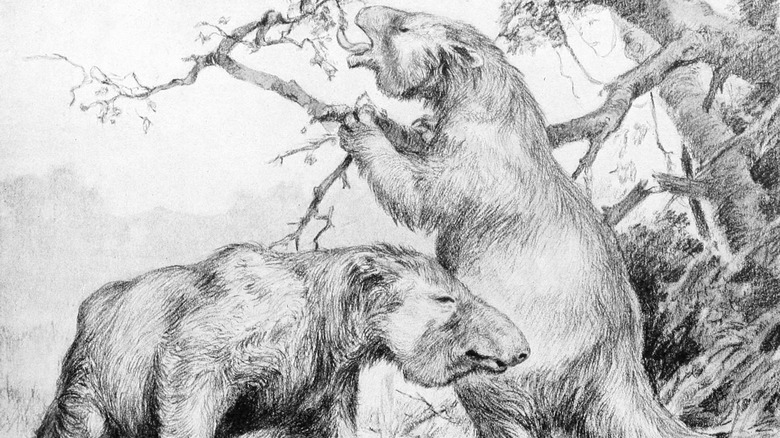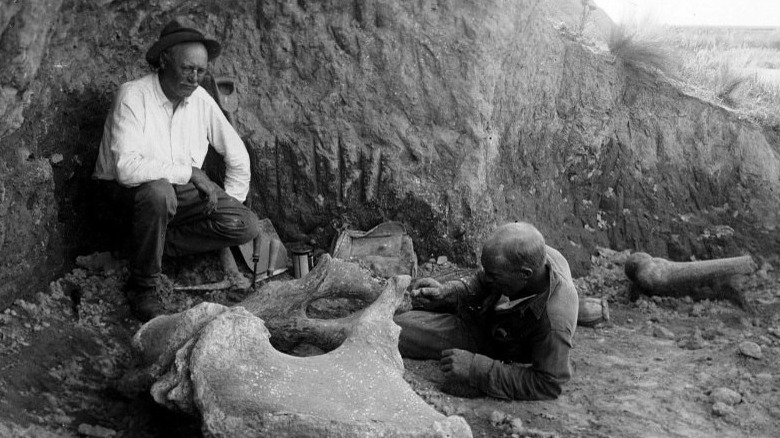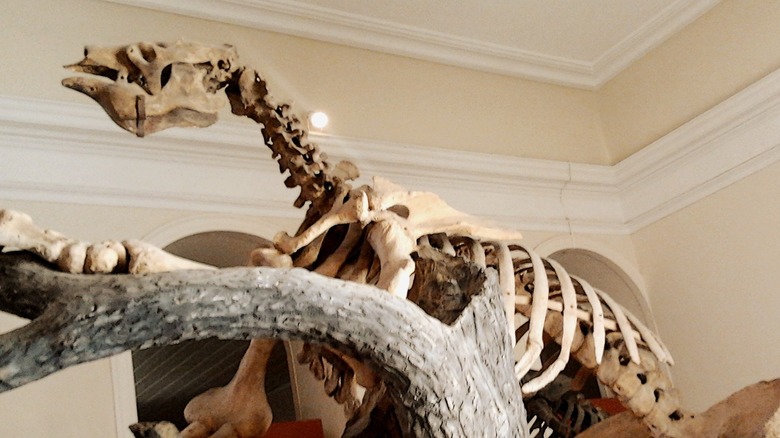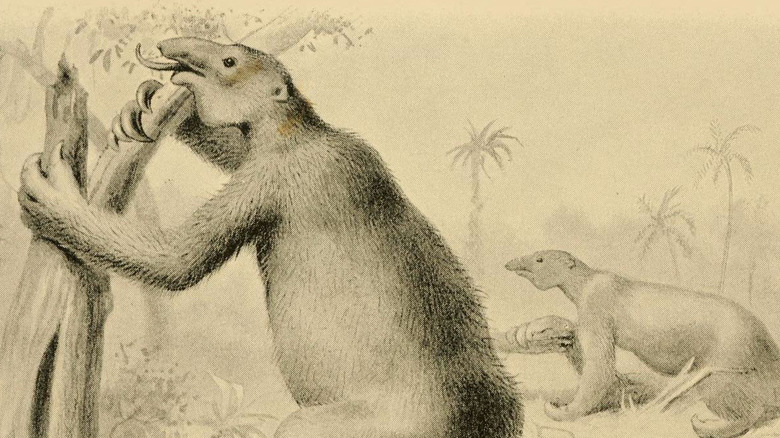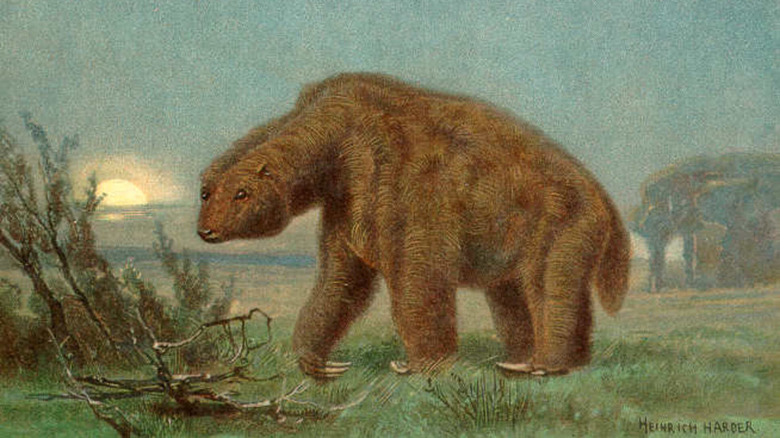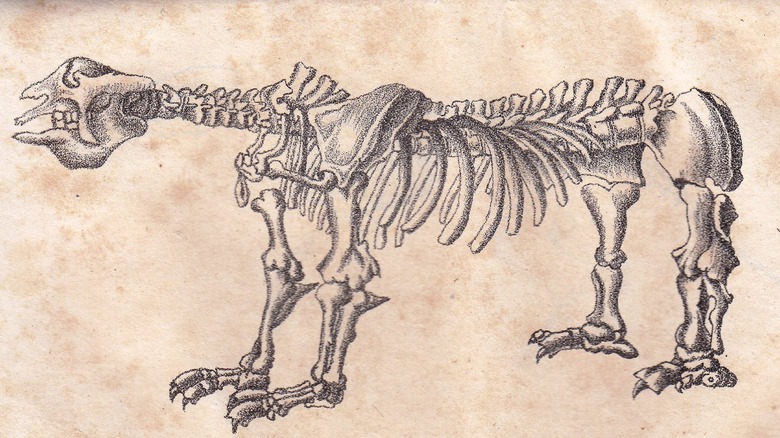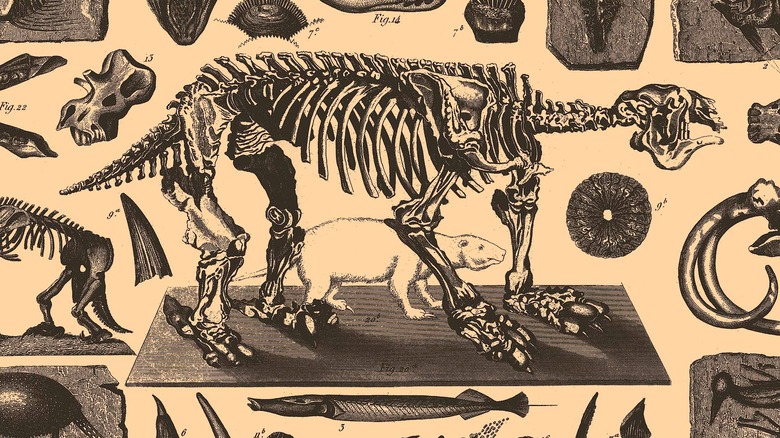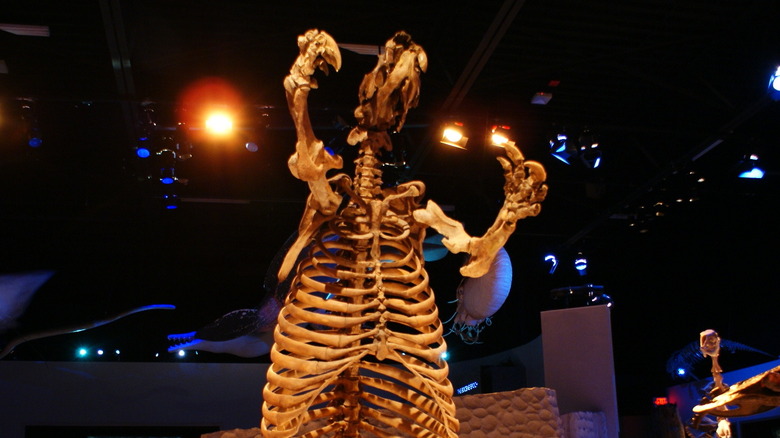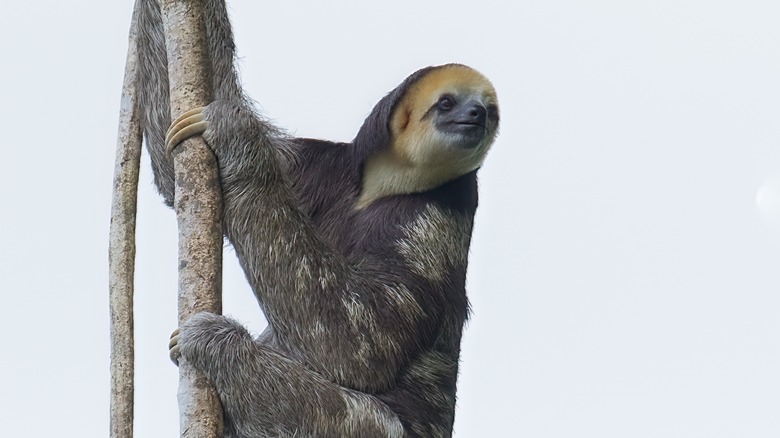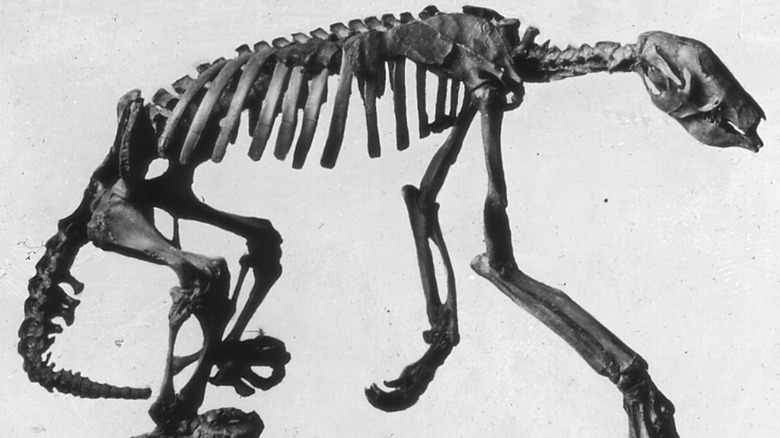Why The Giant Sloth Went Extinct
Modern sloths are small, hairy, brown creatures who live in trees eating leaves and fruit. They are famous for moving incredibly slowly. The largest sloths are no more than 2 ½ feet long and weigh less than 20 pounds (per Smithsonian's National Zoo & Conservation Biology Institute). Their ancestors were giants.
The last ice age was populated by titans like wooly mammoths and saber-toothed tigers. One of the most successful of these massive mammals was the giant ground sloth. There were at least 19 different types of giant ground sloths, but they were all much larger than the tree-dwellers we know today. As described by the National Park Service, smaller varieties of giant ground sloths were 9 feet long and weighed as much as 550 pounds. Larger varieties could weigh more than 2,200 pounds.
Giant ground sloths were among the most successful animals in the ice age, roaming North and South America for millennia. Then, as noted by National Geographic, in the span of just 11,000 years, almost all of the giant ground sloths vanished. What drove these incredible animals to extinction is a question that has plagued scientists since their remains were first discovered in the 1700s.
[Image by Emőke Dénes via Wikimedia Commons | Cropped and scaled | CC BY-SA 4.0]
The exact cause of their death is a mystery
Enormous ground sloths roamed the earth for millions of years. Then, approximately 10,000 years ago, the majority of these remarkable animals vanished, along with many of the other massive creatures that lived in the ice age. Exactly what caused these titans to go extinct, and what made them vulnerable in the first place, is still a mystery. As noted by PBS, there isn't enough data to know for certain what killed the giant ground sloths, but scientists are still looking for clues.
The question of what exactly caused the extinction of the ice age giants has become one of the most hotly debated issues in paleoscience. As described by National Geographic, piecing together a timeline for when these sloths died off in different regions and studying the fossil evidence that they left behind has provided scientists with enough information to form some compelling hypotheses.
They ruled the ice age
The giant ground sloths were certainly massive, with many growing to be the size of a modern-day elephant. They were also prolific. As described by the San Diego Natural History Museum, it's believed that different species of ground sloths had adapted to different environments and were able to thrive in deserts, plains, and jungles alike. As noted by National Geographic, evidence of at least 19 distinct types of giant ground sloth has been found across the Americas and in the Caribbean. They were some of the most successful creatures in the ice age.
As stated by National Geographic, after millions of years of success, approximately 90% of all ground sloths died off in the last 11,000 years. When the majority of the giant ground sloths went extinct in the Americas, the last ice age had just ended. As described by Cosmos Magazine, there were drastic changes in temperature. The giant ground sloths were adept at surviving in different environments, but it's possible they could not survive this massive shift in the climate.
The Earth's megafauna vanished
As strange as the disappearance of many species of giant ground sloths over multiple continents seems, it is actually a part of a much larger pattern. The giant ground sloths were not the only titans to disappear approximately 10,000 years ago. As stated by Cosmos, as recently as 12,000 years ago, massive animals like wooly mammoths, enormous armored armadillos, seven-foot beavers, saber-toothed tigers, and giant ground sloths were common. These animals, and others over 100 pounds, are often referred to as "megafauna," because of their gargantuan sizes.
It's not known for certain what drove so many previously successful species, including the giant ground sloths, to extinction at once, but it wasn't a coincidence. As detailed in an article published by the National Academy of Sciences, between 70% and 80% of all megafauna in the Americas went extinct during this time. In North America, it is believed that around 60 species of megafauna went extinct, along with at least 66 more species in South America.
Humans and giant ground sloths lived at the same time
As bizarre as the idea of humans living alongside prehistoric beasts like giant ground sloths is, there is ample evidence that they not only existed at the same time but interacted. As detailed in a study published in Science Advances, one of the things that has made determining the cause of megafauna extinction in the Americas so difficult is a lack of information about when exactly the extinctions took place. Studies have shown that humans certainly lived in the Americas at the same time as giant ground sloths.
As noted by the journal Quaternary Science Reviews, it is believed that humans had a massive impact on the ecosystems that they migrated to. They may have outcompeted carnivores in Africa, but what impact they had on the megafauna of the Americas is mostly unknown. Many believe that the introduction of humans directly led to the extinction of megafauna, including the giant ground sloth.
Humans may have hunted the ground sloth
The giant ground sloths were formidable, but there is evidence that shows our ancient ancestors may have hunted them. A 2019 study published in Science Advances details the remains of a ground sloth found near a swamp in Argentina which appears to have been hunted and carved up for meat. While this only definitively proves that one sloth was killed and eaten by people, many, including ornithologist David Steadman of the Florida Museum, believe that hunting was the main cause of the megafauna extinction. The humans who arrived in North America around the time of the extinction of the ground sloths made advanced tools out of bone, which they could have used to hunt the giant ground sloths. There is also evidence that humans hunted enormous mastodons and mammoths.
As stated by PBS, this has become known as the "overkill" theory. It is believed that humans reached the Americas for the first time by crossing the Bering Land Bridge, which connected Asia and North America (per National Geographic) and began hunting the local megafauna for food. Within 1,000 years, most of the megafauna were gone.
They were a massive part of the ecosystem
Giant ground sloths were a part of many different ecosystems across the Americas and in the Caribbean. As detailed in a study published by the National Academy of Sciences, megafauna have a massive impact on their ecosystems, and the death of so many species of gigantic animals would have had a tremendous impact on the world around them. Removing the megafauna from their habitats can profoundly change the ecosystems in a short period of time.
The San Diego Natural History Museum describes how some species are believed to have evolved to survive in deserts, eating cacti. Others are believed to have lived on grass, grazing in large open fields. Others may have adapted to wet climates, where they would have stood on their hind legs to rip branches off of trees. As described in a study of Darwin's ground sloth, there is evidence that some ground sloths weren't exclusively herbivores. In an interview with the Natural History Museum, Julia Tejada, the lead author of the study, explained what a major role the giant sloths would have played in their ecosystems.
The extinction of the giant ground sloths would have been a major turning point in the Americas — but the habitats that the giant ground sloths were so connected to were changing as well. Some scientists believe that how well these creatures fit into their environments could have become a liability as the world changed around them.
[Image by Edvaldo LL Souza via Wikimedia Commons | Cropped and scaled | CC BY-SA 4.0]
Climate changes may have destroyed their habitats
The arrival of humans was not the only big change going on when the giant ground sloths vanished. The climate was undergoing extreme changes at the time. As described by the Australian Museum, most of the megafauna, including giant ground sloths, had gone extinct by the end of the last ice age. In North America, tundras were becoming forests. Megafauna evolved for glacial conditions — could they have survived when the ice age was over?
The theory that the drastic change in climate killed off the megafauna, including the giant ground sloths, is sometimes called the "overchill," in contrast to the overkill theory (per PBS). Proponents of overchill have argued that warmer regions such as Africa and South Asia didn't have megafauna die-offs at this time. Not only did megafauna survive the end of the last ice age in these tropical and subtropical areas, these are still the regions where modern megafauna such as elephants and rhinos live.
Experts are still debating
There are multiple compelling theories about what exactly killed the giant ground sloths and the other megafauna in the Americas, and no consensus has yet been reached. While all the theories have their advocates, they have critics as well.
The overkill theory is one of the most popular explanations for the extinctions, and there is evidence that the humans who arrived in the Americas hunted giant ground sloths for meat. As described by PBS, some argue that the group of people who came to the Americas was relatively small and would never have been able to cause the extinctions of so many highly successful species on their own in such a short time.
The overchill theory is also widely accepted, and no one denies that there were radical changes to the environment around the time of the megafauna extinction. However, some experts argue that in the 2 million years before, there are multiple examples of drastic changes in the climate that megafauna such as giant ground sloths survived.
There may have been a deadly disease
It is believed that the Americas had been fairly isolated before the arrival of humans on the Bering Land Bridge. Some experts believe that it wasn't over-hunting that drove the giant ground sloth and other American megafauna to extinction, but something else that humans brought with them: disease.
This theory is often called the Hyperdisease theory, or jokingly the "overill" theory, to match the nicknames of the overkill and overchill theories. As described by PBS, humans certainly arrived in the Americas at this time, and they likely brought other animals with them, including dogs and rats. The humans and their animals may have been carrying diseases like rabies, which the native creatures of the Americas had never been exposed to before. Without immunity, it could have spread quickly and devastated the population.
There is no physical evidence that the giant ground sloths were killed by disease, and researchers have failed to find any sign of pathogens on megafauna remains that might indicate they were killed by an epidemic. However, as described by the American Museum of Natural History's curator of mammalogy for Scientific American, there are many examples in history of animals being wiped out by diseases spread by newcomers to the region.
There might have been a meteor
The best-known mass extinction is certainly the dinosaurs, which were killed by a meteor impact. Some experts have recently started to suspect that something similar happened to the ground sloths and their other enormous contemporaries. This is jokingly called the "overgrill theory." As detailed by a study published in Science Daily, there is a theory that impacts from comets or meteorites striking the planet could have caused major changes in the climate that led to the extinction of the megafauna.
As described by PBS, fossils from about 15 varieties of mammals and a group of humans known as the Clovis people seem to disappear at about the same time (approximately 12,900 years ago). Scientists have seen some evidence of a catastrophic event in a layer of soil made up of charcoal, soot, and "microscopic diamonds." Some believe that this is evidence of a comet burning up in the atmosphere, blocking out the sun with smoke, and causing massive wildfires. This layer of soil is referred to as a "black mat." In the soil older than the mat, fossils from extinct species and tools made by the Clovis people can be found. In the soil newer than the mat, there don't seem to be any traces of the Clovis people or the extinct mammals.
Some species survived on islands for thousands of years
Understanding the timeline of when giant ground sloths died out may provide clues to exactly what caused them to go extinct. As described by National Geographic, the most recent evidence of giant ground sloths in North America dates back 11,000 years, while in South America there is no evidence of ground sloths after about 10,200 years ago. In the Caribbean, however, the sloths survived.
Evidence has been found of giant ground sloths living on various islands in the Caribbean approximately 5,000 years after the last known ground sloth in South America. These were not the same varieties of sloths that died out in North and South America. In fact, it is believed that there were 13 species of giant ground sloths that only lived in the Caribbean. These sloths were not as massive as some of the other species, but they were still much larger than their modern counterparts, some weighing about 200 lbs. It has been suggested that the extinction of these Caribbean sloths might have been spurred by the arrival of humans on their islands, but it's also believed that in some areas ground sloths may have coexisted with human beings for more than 1,000 years.
[Image by Dallas Krentzel via Wikimedia Commons | Cropped and scaled | CC BY 2.0]
The closest relatives of ground sloths are still alive
While the giant ground sloths went extinct, their descendants survived. The closest relatives of the giant ground sloths are small, tree-dwelling sloths, though as noted by the San Diego Natural History Museum, they are also related to modern armadillos and anteaters.
Modern sloths may be tiny compared to their enormous ancestors (the pygmy three-toed sloth weighs less than 8 pounds), but they have adapted to thrive in the dense tropical forests of South America. As described by the World WIldlife Fund, these slow-moving sloths travel easily through the forest and sleep in the treetops for at least 15 hours a day.
There are six surviving species of sloth, but two of them are at risk. The maned sloth is classified as vulnerable, while the pygmy three-toed sloth is critically endangered. As noted by Cosmos, the planet is currently facing a crisis sometimes called the "sixth mass extinction." Experts hope that understanding what led to the megafauna extinctions thousands of years ago may give insight into how to protect modern species, like the sloths.
Some people want to bring the ground sloths back from the dead
The giant ground sloths have been extinct for thousands of years, but that doesn't necessarily mean it's the end. De-extinction is defined by Britannica as a theoretical method for bringing back extinct species through cloning and selective breeding. This was almost achieved in 2009 when scientists used preserved tissues from the extinct Pyrenean ibex to clone one. The animal did not survive, but it is theoretically possible.
The idea of resurrecting megafauna like the giant ground sloth is not as far-fetched as it might seem. Some scientists, including paleontologist Michael Archer (via National Geographic), have argued that if humans played a direct role in the extinction of a species, we have a moral obligation to try to bring it back. There is also the possibility that bringing these animals back, or introducing modern megafauna that fills the same niche, could help save the environment. This concept has been referred to as "Pleistocene rewilding" (per The New York Times).
As recounted by Salon, some believe that the Shasta ground sloth would be the ideal species to bring back, because of the unique role that they played in their ecosystem. Due to climate change, there is a risk that Joshua trees will die out, which would have a catastrophic effect on the ecosystem. The Shasta ground sloth is believed to have eaten the seeds of Joshua trees and by digesting them, helped them spread. Reintroducing the ground sloths could save the Mojave Desert.
